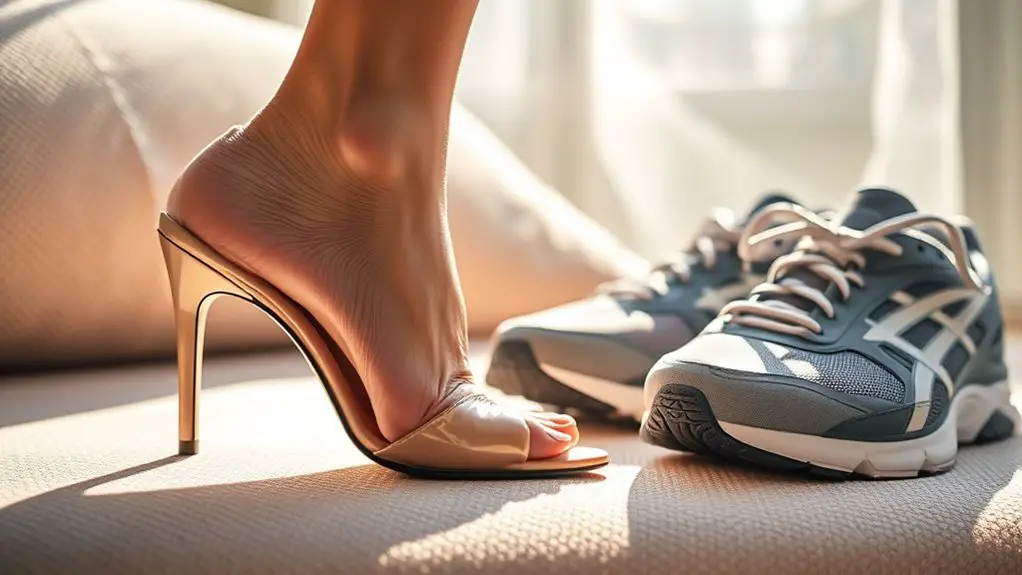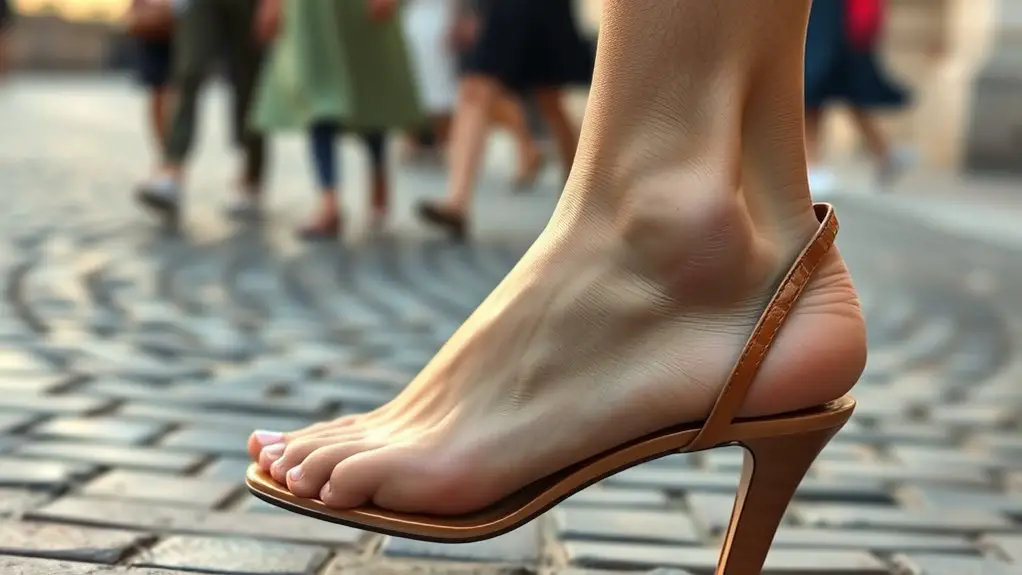Wearing high heels can indeed make your ankles weak over time. The elevated heel alters your gait and reduces ankle mobility, which destabilizes your balance and increases the risk of injuries. This imbalance leads to muscle fatigue and can result in weakened ankle and calf muscles. Consequently, long-term use may contribute to chronic pain and discomfort. If you’re interested in preventing these issues and exploring healthier footwear options, there’s more valuable information available for you to contemplate.
The Anatomy of the Ankle

The ankle is a complex joint that plays an essential role in mobility and stability. It consists of three primary bones: the tibia, fibula, and talus. These bones are held together by ligaments, which provide joint stability and limit excessive movement. The ankle’s ligaments include the anterior talofibular, calcaneofibular, and deltoid ligaments, each serving a specific function to prevent injuries like sprains.
In addition to bones and ligaments, the ankle has a variety of tendons that connect muscles to the bones, facilitating movement. The primary muscles involved are the gastrocnemius and soleus, which help you push off the ground and maintain balance. Understanding ankle anatomy is vital for recognizing how it supports your body’s weight and allows for activities like walking, running, and jumping. Proper knowledge about this joint can aid in injury prevention and rehabilitation, ensuring long-term health and mobility.
How High Heels Affect Foot Mechanics
Wearing high heels alters your gait patterns, which can lead to muscle imbalances over time. These changes in foot mechanics not only affect your posture but also increase your risk of injury. Understanding these effects is vital for maintaining foot health and preventing long-term issues.
Altered Gait Patterns
Although high heels may enhance your appearance, they considerably alter your gait patterns and foot mechanics. Wearing heels can lead to reduced ankle mobility, impacting your balance and stability. This change in posture may necessitate adaptations in your walking style, which can have long-term consequences.
- Shortened stride length: Your heels can cause you to take shorter steps, affecting overall mobility.
- Increased pressure on the forefoot: The elevation shifts your weight forward, leading to altered weight distribution.
- Proprioceptive disruption: High heels can impair your ability to sense foot position, making proprioceptive training essential for maintaining balance and coordination.
To mitigate these effects, consider stretching and strengthening exercises focused on ankle mobility and balance.
Muscle Imbalance Development
As high heels elevate the heel and shift the body’s center of gravity, they create muscle imbalances that can lead to various foot and ankle problems. When you wear heels, your calf muscles shorten, prompting muscle compensation from other areas, like your shins and thighs, to maintain stability. This altered muscle engagement can disrupt joint alignment, placing undue stress on your ankles and feet. Over time, these compensatory mechanisms may result in decreased strength and flexibility. The imbalance not only affects your foot mechanics but can also lead to chronic pain and discomfort. By understanding these effects, you can make informed choices about footwear to promote better muscle balance and overall joint health.
Increased Injury Risk
High heels can considerably alter foot mechanics, increasing the risk of injury. When you wear high heels, several instability factors come into play, making you more susceptible to ankle sprains. These factors include:
- Altered Center of Gravity: Your weight shifts forward, destabilizing your balance.
- Reduced Ankle Mobility: High heels limit the ankle’s natural range of motion, leading to stiffness and vulnerability.
- Muscle Fatigue: The calf muscles engage excessively to maintain balance, leading to fatigue and a higher probability of missteps.
As a result, the combination of these factors can lead to a greater likelihood of falls and ankle injuries, highlighting the importance of considering footwear choices in relation to your overall foot health.
The Impact of Heel Height on Stability
When you wear heels, the height can greatly affect your stability, as greater elevation shifts your center of gravity. Higher heel height often leads to increased stability issues, making it harder to maintain balance. When your heels are elevated, the muscles and ligaments in your ankles adapt to support this change, which can lead to weakness over time. This adjustment can compromise proprioception—the body’s ability to sense its position in space—resulting in a less stable stance.
Additionally, wearing heels can alter the biomechanics of your gait, forcing you to adjust your stride and posture, which can further exacerbate stability problems. The taller the heel, the more pronounced these effects become, as your foot’s angle increases, putting additional strain on your joints. Ultimately, frequent wear of high heels can lead to a reliance on these altered mechanics, making it essential to evaluate heel height when choosing footwear.
Common Injuries Associated With High Heel Wear

While many enjoy the aesthetic appeal of high heels, their frequent use can lead to several common injuries that affect the feet and ankles. These injuries can greatly impact your mobility and comfort. Here are three prevalent issues associated with high heel wear:
- Ankle Sprains: Wearing high heels increases the risk of twisting your ankle, leading to painful sprains. The elevated position and unstable base make your ankles more susceptible to injury.
- Heel Pain: The pressure exerted on the heel can cause inflammation and pain, often resulting in conditions like plantar fasciitis. This discomfort can limit your ability to walk comfortably.
- Metatarsalgia: The weight distribution in high heels can lead to pain in the ball of the foot, creating challenges in daily activities.
Understanding these risks can help you make informed choices about footwear and prioritize your foot health.
Long-term Consequences of Regular High Heel Use
Wearing high heels regularly can lead to muscle weakness over time, particularly in your ankles and calves. This alteration in muscle strength can change your gait mechanics, potentially causing you to walk differently than intended. As a result, you may face an increased risk of injuries, not just in your feet but throughout your lower body.
Muscle Weakness Over Time
Although many women enjoy the aesthetic appeal of high heels, regular use can lead to significant muscle weakness over time. This weakness often affects your ankle stability, making it essential to understand the implications of prolonged wear. Here are three key consequences you might experience:
- Decreased Muscle Strength: Continued reliance on heels can weaken the muscles that support your ankles, impairing overall function.
- Increased Injury Risk: Weak muscles compromise your ability to stabilize your ankle, increasing the likelihood of sprains or strains.
- Need for Muscle Rehabilitation: To recover strength, you may require targeted rehabilitation exercises that focus on restoring muscle function and stability.
Being aware of these factors can help you make informed choices about your footwear and its long-term effects on your health.
Altered Gait Mechanics
High heels not only affect muscle strength but also considerably alter your gait mechanics over time. Gait analysis reveals that wearing heels leads to significant biomechanical changes, including altered stride length and increased heel strike impact. These modifications can cause you to adopt compensatory movements, which may place undue stress on your knees and hips. Over time, these changes can result in a less efficient walking pattern, potentially leading to muscle imbalances and discomfort. Additionally, the shift in your center of gravity forces your body to adjust, further affecting your overall stability. As a result, it’s essential to be aware of how regular high heel use can influence your gait and long-term musculoskeletal health.
Increased Injury Risk
When regularly donning high heels, you considerably increase your risk of various injuries, particularly in the lower extremities. The elevated heel height alters your balance and stability, predisposing you to conditions like ankle sprains. Here are three key injury risks associated with high heel use:
- Ankle Sprains: The unnatural angle can strain ligaments, making sprains more likely.
- Fractures: High heels can lead to falls, resulting in fractures, especially in the foot and ankle.
- Tendon Injuries: Prolonged wear can cause overuse injuries, affecting the Achilles tendon and leading to pain.
Understanding these risks can help you make informed choices about heel height and your footwear to minimize injury potential.
Strengthening Exercises for Ankle Stability
To maintain strong and stable ankles, incorporating targeted strengthening exercises into your routine is essential. Focus on exercises that enhance ankle mobility and stability. Start with calf raises to strengthen your calf muscles, which support ankle function. Gradually progress to single-leg balances, which not only improve strength but also enhance proprioception training. This training helps your body recognize the position of your ankle in space, reducing the risk of injury.
Another effective exercise is the resistance band ankle flexion. It targets the muscles around the ankle joint and improves overall stability. Additionally, try lateral band walks to strengthen the muscles on the outer part of your ankle. Consistency is key; aim for at least two to three sessions per week. By integrating these exercises, you’ll not only boost your ankle strength but also improve your balance and coordination, essential for any physical activity, especially if you often wear heels.
Choosing the Right Footwear for Ankle Health

Selecting the right footwear is crucial for maintaining ankle health, especially if you frequently wear heels. Proper shoes can greatly impact the strength and stability of your ankles. Here are three key features to evaluate:
Choosing the right shoes is essential for ankle health, particularly for frequent heel wearers. Proper footwear enhances ankle strength and stability.
- Foot Arch Support: Choose shoes that offer adequate arch support to distribute weight evenly and reduce strain on your ankles. This support can help prevent injuries and provide stability.
- Cushioning Materials: Opt for footwear made with high-quality cushioning materials. These materials absorb shock, reduce impact on your joints, and enhance comfort, which is essential for ankle health.
- Stability Features: Look for shoes designed with stability features, such as a wider base or ankle support. These elements can help prevent excessive rolling or twisting of the ankle during movement.
Balancing Fashion and Functionality in Footwear
While style often takes precedence in footwear choices, it’s essential not to overlook functionality, especially when considering the impact on your ankles. Many current fashion trends prioritize aesthetics over comfort, leading to potential ankle weakness and instability. High heels, for instance, can alter your natural gait and place undue stress on your ankle joints.
However, footwear innovation is making strides in balancing these two aspects. Brands are now designing shoes that integrate supportive elements without sacrificing style. Look for options that combine modern designs with features like arch support, cushioning, and ankle stability. By prioritizing shoes that offer both fashion and functionality, you not only stay on-trend but also protect your ankle health. Ultimately, being mindful of your footwear choices can lead to a more sustainable approach to style, ensuring your ankles remain strong and resilient.
Frequently Asked Questions
Can High Heels Cause Permanent Ankle Damage Over Time?
High heels, particularly those with significant heel height, can compromise ankle stability over time. Prolonged use may increase the risk of chronic injuries, potentially leading to permanent damage if proper care and alternatives aren’t considered.
Do Different Heel Styles Affect Ankle Strength Differently?
Imagine a tree swaying in the wind—different heel types can impact your ankle stability similarly. Stilettos may strain, while block heels provide more support. Each style influences the strength and resilience of your ankles over time.
Are There Specific Foot Shapes More Prone to Ankle Weakness?
Certain foot shapes, like flat feet, may contribute to ankle weakness due to inadequate arch support. Conversely, those with high arches might also experience instability, highlighting the importance of tailored footwear for individual foot types.
How Do Age and Gender Influence Ankle Strength With Heel Use?
Isn’t it fascinating how age effects and gender differences shape your ankle strength? As you age, muscle mass declines, while women often face greater challenges due to anatomical differences, impacting stability when wearing heels.
Can Ankle Braces Help When Wearing High Heels?
Ankle braces can provide essential ankle support while wearing high heels, enhancing heel stability. They help reduce the risk of injury by stabilizing the ankle joint, especially during activities that require balance and agility in elevated footwear.



